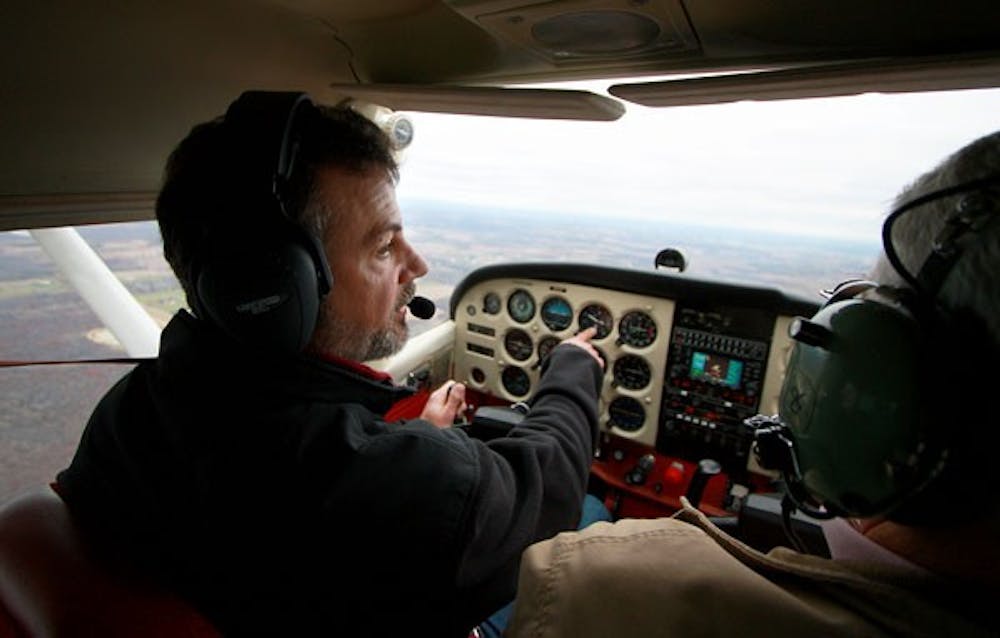CMU associate vice president Barrie Wilkes learning to fly on the side

ALMA — Barrie Wilkes has his head in the clouds.
And those clouds are more than 2,000 feet in the air.
Wilkes, associate vice president of Financial Services and Reporting who oversees five different offices at Central Michigan University, is working on getting his pilot’s license while not in the office.
“I just like to do new things,” Wilkes said. “It’s a good stress release.”
Wilkes’ father was a pilot in the U.S. Air Force, and his brother also has his pilot’s license. With exposure to it growing up and having a place in the Upper Peninsula his family likes to visit, he figured getting his license would be a good idea.
A view from above
Wilkes, 53, prepared to make a practice run Sunday with instructor Daryl Koch, climbing into a Cessna 172 Skyhawk at the Gratiot Community Airport in Alma. The plane is about 23 feet long with 160 horsepower behind the single engine.
Wilkes put on his headset to better communicate over the engine noise with Koch and other towers. He taxied the plane to a spot on the runway, where he began to rev the engine and check all the monitors.
In the plane, steering is done with the feet, said Koch, who has been a certified flight instructor since 1977.
“The one thing you have to get used to is the steering,” he said.
As the plane ascended to 2,800 feet above sea level, the visibility was clear enough to see 50 miles in most directions, allowing Wilkes and Koch to see parts of Lansing.
“The world looks a lot different from here,” Wilkes said.
Wilkes began his training in September 2008 and hopes to get his license in the next couple months.
Although Wilkes was exposed to flying growing up, the learning process still has its struggles.
“The most difficult part of flying is landing,” he said.
Wilkes said the interesting part about flying is, in the first lesson, he was actually flying the plane. He started off by taxiing the plane around on the ground to learn steering.
“All these switches and knobs. Do this. Do that. You don’t have a clue,” Wilkes said.
The art of flying
The first time Wilkes got in the pilot’s seat, he moved along slow and steady, he said.
“I reminded myself of the student drivers I see in town,” Wilkes said.
There are three main axis controls to fly the plane, Koch said.
The yaw, which is the back and forth movement of the plane, is controlled by the rudder pedals.
The pitch and roll are managed by the control wheel. The pitch is where the nose goes up or down and the roll moves the wheel side to side.
“Blending all those controls together ... is the basics of learning to fly,” Koch said. “The hardest part, I feel, is getting the student to develop the coordination to keep the plane under really good control.”
To get his license, Wilkes will have to fly a minimum of 40 hours. Twenty of those hours have to be with Koch, and the other 20 hours will be a combination of solo, cross country and night flights, Koch said.
Once Wilkes meets all the requirements, he will take a written, oral and practical exam, which could take half a day to complete. Koch does not have any doubts Wilkes will pass the test.
“He’s a very intelligent man. Look at his position at the college,” he said. “He has a good background.”
‘Fresh perspective’
Learning to fly a plane has been an experience, to say the least.
It gives people a different view of Wilkes outside of his finance-crunching personality at work.
Wilkes’ wife, Sharon, said she was surprised at first when she heard he wanted to get his license. But she thinks it is great that he has a hobby he can do with his brother and father.
“He’s typically pretty conservative,” she said. “I think you choose to do things at points in life when it makes sense.”
But Wilkes does use some of the same skills in the air that he does at work.
There is a lot of planning involved with plotting a course and tying to figure out what the wind is going to do.
“It does require that you pay attention to detail,” he said. “It’s totally different than anything I’ve ever done.”



